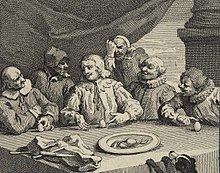 | ||
Tesla s egg of columbus world s largest and heaviest functional replica
An egg of Columbus or Columbus' egg (Italian: uovo di Colombo [ˈwɔːvo di koˈlombo]) refers to a brilliant idea or discovery that seems simple or easy after the fact. The expression refers to an apocryphal story in which Christopher Columbus, having been told that discovering the Americas was inevitable and no great accomplishment, challenges his critics to make an egg stand on its tip. After his challengers give up, Columbus does it himself by tapping the egg on the table to flatten its tip.
Contents
- Tesla s egg of columbus world s largest and heaviest functional replica
- Teslas egg of columbus exhibit
- Source of the story
- In popular culture
- References
The story is often alluded to when discussing creativity. The term has also been used as the trade name of puzzles.
Teslas egg of columbus exhibit
Source of the story
The Columbus story may have originated with Italian historian and traveler Girolamo Benzoni. In his book History of the New World, published in 1565, he wrote:
Columbus was dining with many Spanish nobles when one of them said: 'Sir Christopher, even if your lordship had not discovered the Indies, there would have been, here in Spain, which is a country abundant with great men knowledgeable in cosmography and literature, one who would have started a similar adventure with the same result.' Columbus did not respond to these words but asked for a whole egg to be brought to him. He placed it on the table and said: 'My lords, I will lay a wager with any of you that you are unable to make this egg stand on its end like I will do without any kind of help or aid.' They all tried without success and when the egg returned to Columbus, he tapped it gently on the table breaking it slightly and, with this, the egg stood on its end. All those present were confounded and understood what he meant: that once the feat has been done, anyone knows how to do it.
The factual accuracy of this story is called into question by its similarity to another tale published fifteen years earlier (while Benzoni was still traveling in the Americas) by painter and architect Giorgio Vasari. According to Vasari, the young Italian architect Filippo Brunelleschi had designed an unusually large and heavy dome for Santa Maria del Fiore, the cathedral (Duomo) in Florence, Italy. City officials had asked to see his model, but he refused, proposing instead:
That whosoever could make an egg stand upright on a flat piece of marble should build the cupola, since thus each man's intellect would be discerned. Taking an egg, therefore, all those Masters sought to make it stand upright, but not one could find a way. Whereupon Filippo, being told to make it stand, took it graciously, and, giving one end of it a blow on the flat piece of marble, made it stand upright. The craftsmen protested that they could have done the same; but Filippo answered, laughing, that they could also have raised the cupola, if they had seen the model or the design. And so it was resolved that he should be commissioned to carry out this work.
When the church was finally built it had the shape of half an egg slightly flattened at the top.
In popular culture
Mary Shelley mentions Columbus's egg in her Introduction to the Third Edition of Frankenstein, writing "In all matters of discovery and invention, even of those that appertain to the imagination, we are continually reminded of the story of Columbus and his egg. Invention consists in the capacity of seizing on the capabilities of a subject, and in the power of moulding and fashioning ideas suggested to it."
Adolf Hitler uses the metaphor is his autobiographical Mein Kampf, saying that "Columbus's eggs lie around by the hundreds of thousands, but Columbuses are met with less frequency".
